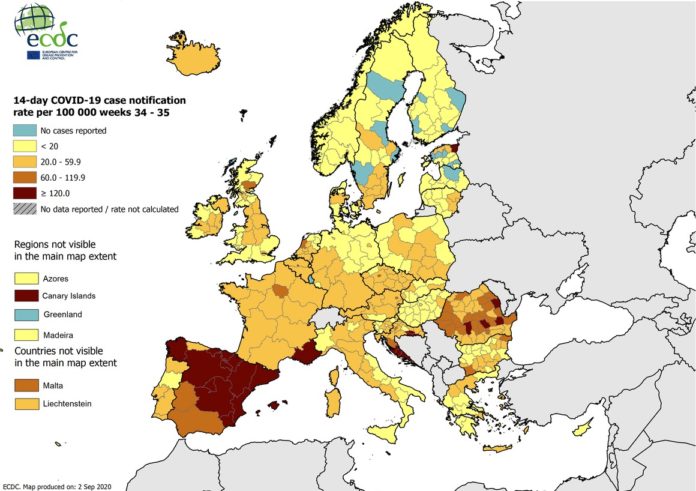The European Commission recently adopted a proposal to ensure that Covid-19 measures taken by the 27-member states that restrict free movement are coordinated and communicated.
The European Commission’s proposal sets out four key areas where member states should work together.
First, common criteria and thresholds for member countries when deciding whether to introduce travel restrictions should be established. Second, there should be a mapping of common criteria using an agreed color code. Third, a common framework for measures applied to travelers from high-risk areas and lastly, for clear and timely information to the public about any restrictions.
Commissioner for Health and Food Safety, Stella Kyriakides said:
“Today we propose to our Member States a well-coordinated, predictable, and transparent approach to travel restrictions where these are needed, always placing the protection of public health first. We must avoid further disruption of already fragile economies and additional uncertainty for citizens who have made huge sacrifices. They expect this from us after so many months living with COVID-19.”
Commissioner for Justice, Didier Reynders, said in a statement that the right to move freely in the EU has been heavily impacted by the pandemic.
“For the many citizens who rely on frictionless travel every day, the cacophony of national rules in the EU is overwhelming. We want to simplify things. We are proposing straightforward criteria, applicable without discrimination, which are easy to follow by the Member States and allow to inform Europeans properly.”
Home Affairs Commissioner Ylva Johansson said that since March, the EU has developed and delivered a solid foundation of internal and external border control recommendations for its 27-member bloc to follow.
“Today’s measures build on this track record so that we can fully benefit from our Schengen area. That is why we want a clear ‘green, orange, red’ system and not a kaleidoscope of individual measures,” Johansson said.
European Commission: Wide discrepancy on national criteria
According to the commissioners, there is currently a wide discrepancy between national criteria for introducing measures that restrict free movement in the European Union.
To address this, the European Commission proposed that each EU member takes into account the following criteria when putting in place any restrictive measures:
- The total number of newly notified COVID-19 cases per 100 000 people in a given area in 14 days;
- The percentage of positive tests from all COVID-19 tests carried out in a given area for seven days;
- The number of COVID-19 tests carried out per 100 000 people in a given area for seven days.
Commissioners said EU members should provide this data weekly to the European Centre for Disease Prevention and Control. EU countries should also provide this data at the regional level to ensure that any measures can be targeted to those regions where they are strictly necessary.
Free movement should also not be restricted when the total number of newly notified COVID-19 cases in a given area is equal to less than 50 per 100 000 people in 14 days.
Movement restriction shall also not be imposed when the percentage of positive tests from all COVID-19 tests in a given area is less than 3%.
Based on the data provided by EU members, the European Commission proposes that the European Centre for Disease Prevention and Control publishes a map of EU and EEA countries, updated weekly, with a common color code composed of colors green, orange, red, and grey to support EU countries and their travelers.
Here’s what each color code means:
- Green for an area where the total number of newly notified COVID-19 cases is less than 25 during a 14-day period and the percentage of positive tests from all COVID-19 tests is less than 3%;
- Orange for an area where the total number of newly notified COVID-19 cases is less than 50 during a 14-day period but the percentage of positive tests from all COVID-19 tests is 3% or more OR the total number of newly notified COVID-19 cases is between 25 and 150 BUT the percentage of positive tests from all COVID-19 tests is less than 3%;
- Red for an area where the total number of newly notified COVID-19 cases is more than 50 during a 14-day period AND the percentage of positive tests from all COVID-19 tests is 3% or more OR the total number of newly notified COVID-19 cases is more than 150 per 100 000 people during a 14-day period;
- Grey if there is insufficient information available to assess the criteria proposed by the Commission OR the number of COVID-19 tests carried out per 100 000 people is less than 250.
The European Commission also proposes a common approach amongst member states when dealing with travelers coming from ‘high-risk’ zones. EU countries should not refuse the entry of persons traveling from other EU-member countries and that they introduce restrictions to free movement based on their decision-making processes.
Read More: US Defense Dept. mulls placing Chinese Chipmaker SMIC in Trade Blacklist



